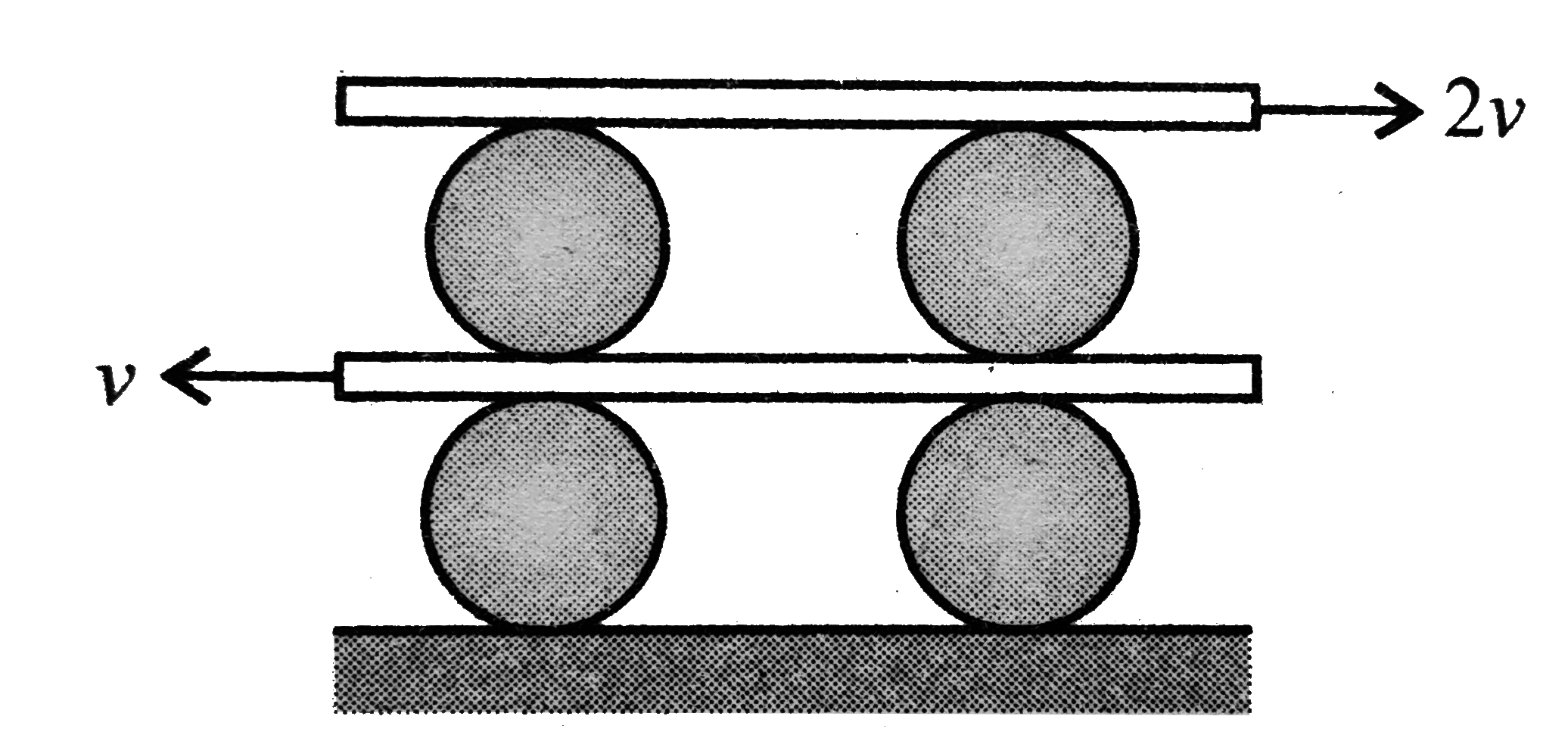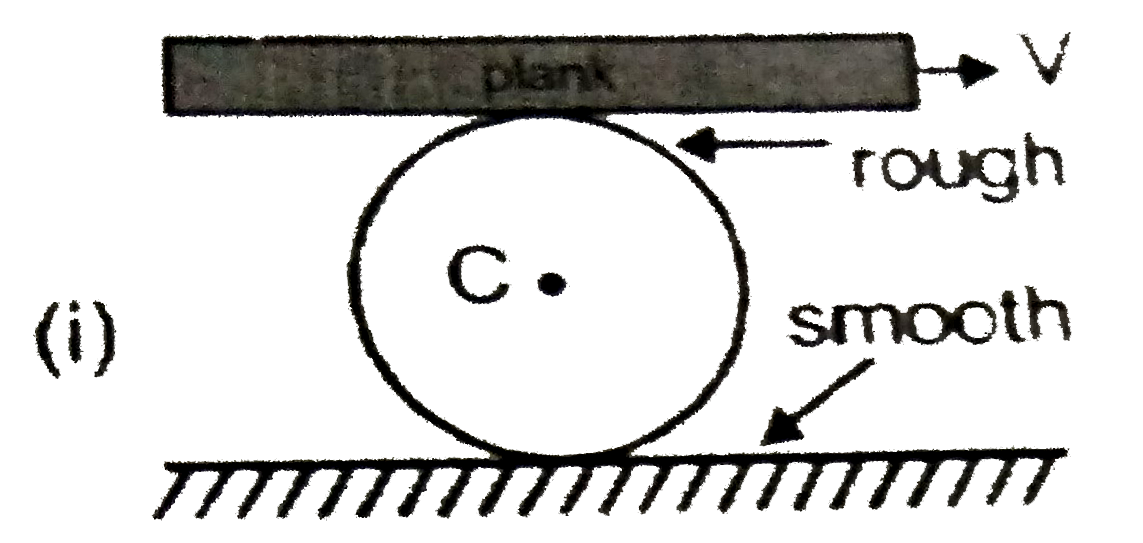A system of identical cylinders and plates is shown in Fig. All the cylinders are identical and there is no slipping at any contact. The velocity of lower and upper plates are V and 2V, respectively, as shown in Fig. Then the ratio of angular speeds of the upper cylinders to lower cylinders is

13
3
1
none of the above
The correct Answer is:B

Angular velocity of the upper cylinder is
ωup=2v−(−v)2R=3v2R, for the lower cylinder
ωlower=v−02R=v2R
Hence ratio ωupωlower=3
Topper's Solved these Questions
- RIGID BODY DYNAMICS 2BOOK - CENGAGE PHYSICSCHAPTER - RIGID BODY DYNAMICS 2EXERCISE - Multiple Correct
26 Videos
- RIGID BODY DYNAMICS 2BOOK - CENGAGE PHYSICSCHAPTER - RIGID BODY DYNAMICS 2EXERCISE - Linked Comprehension
71 Videos
- RIGID BODY DYNAMICS 2BOOK - CENGAGE PHYSICSCHAPTER - RIGID BODY DYNAMICS 2EXERCISE - Subjective
19 Videos
- RIGID BODY DYNAMICS 1BOOK - CENGAGE PHYSICSCHAPTER - RIGID BODY DYNAMICS 1EXERCISE - Integer
11 Videos
- SOUND WAVES AND DOPPLER EFFECTBOOK - CENGAGE PHYSICSCHAPTER - SOUND WAVES AND DOPPLER EFFECTEXERCISE - Integer
16 Videos
Similar Questions
Two thin planks are moving on a four identical cylinders as shown. There is no slipping at any contact points. Calculate the ratio of angular speed of upper cylinder to lower cylinder

View SolutionA cylinder of mass 2kg and radius 10cm is held between two planks as shown in Fig. Calculate KE of the cylinder when there is no slipping at any point.

View Solution
Knowledge Check
A system is shown in fig. Assume that the cylinder remains in contact with the two wedge. Then the velocity of cylinder is
 A√19−4√3ms−1B√13u2ms−1C√3ums−1D√7ms−1
A√19−4√3ms−1B√13u2ms−1C√3ums−1D√7ms−1Velocity of the centre of a small cylinder is v. There is no slipping anywhere. The velocity of the centre of the larger cylinder is
 A2vBvC3v2Dnone of the above
A2vBvC3v2Dnone of the aboveThere are four arrangements of a solid cylinder and a plank as shown in the figures. Some surfaces are smooth and some are rough as indicated . There is no slipping at each rough surface. The plank and / or centre of cylinder are given a horizontal constant velocity as shown in each of the situations. Usinn this information fill in the blanks.
 The speed of center of mass of the cylinder is ..........................
The speed of center of mass of the cylinder is ..........................
(ii) , The angular velocity of the cylinder is ........................
The angular velocity of the cylinder is ........................
(iii),(RESPHYDPP04_XIE01537_Q03.png width=80%>Thespeedofcenterofmassofthecyl∈dris................<br>(iv),<imga≤ocr_imageload∈g=lazysrc=https://d10lpgp6xz60nq.cloudfront.net/physics_images/RES_PHY_DPP_04_XI_E01_537_Q04.pngwh=80%mx-autosty≤=background:white;>Theanga––rvelocityofthecyl∈deris.............<br>(a) V<br>(b) V//R<br>(c) 2V//R<br>(d) 4V//R<br>(e)ca∩otbedeterminedomthegiven∈formation<br>(f) Zero.A(i)d(ii)b(ii)f(iv)cB(i)e(ii)v(iii)f(iv)bC(i)e(ii)d(iii)f(iv)cD(i)e(ii)v(iii)f(iv)a
Three identical cylinders have mass M each and are placed as shown in the figure. The system is in equilibrium and there is no contact between B and C. Find the normal contact force between A and B.

View SolutionFigure shows two cylinders of raddi r1andr2 having moments of inertia I1andI2 about their respective axes. Initially the cylinders rotate about their axes with angular speed ω1andω2 as shown in the figure. The cylinders are moved closer to touch each other keeping the axes parallel. The cylinders first slipover each other at the contact but the slipping finally ceases due to the friction between them. Find the angular speeds of the sylinders after the slipping ceases.

View SolutionThe diameter and height of a cylinderical plate are 14 cm and 2 cm respectively. 20 such plates are stacked up to make a larger cylinder. Find the volume of this larger cylinder.
View SolutionA cylinder A rolls without slipping on a plank B.The velocities of center of the cylinder and that of the plank are 4m/s and 2m/s respectively in same direction,with respect to the ground.Find the angular velocity ( in rad /sec) of the cylinder if its radius is 1m .
View SolutionA boy pushes a cylinder of mass M with the help of a plank of mass m as shown in figure. There is no slipping at any contact. The horizontal component of the force applied by the boy on the plank is F. Find
(a) The acceleration of the centre of the cylinder
(b) The friction force between the plank and the cylinder

View Solution
